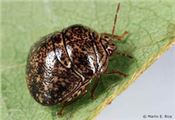|
Be On The Lookout For Kudzu Bugs
DR. MIKE MILAM
KENNETT, MO.
Megacopta cribraria, also called the bean plataspid, kudzu bug, kudzu beetle, globular stink bug and lablab bug, is a shield bug native to India and China, where it is an agricultural pest of lablab beans and other legumes.
Hosted by wisteria, green beans, and other legumes, the insect sucks juice from the stems of soybean plants and reduces crop yield. However, when the insect infests kudzu, another invasive species, it appreciably reduces the growth of that plant. The kudzu bug was introduced from Asia, where it is widespread. It is the only representative of the family Plataspidae in North and South America. The insect taps through the veins of plants to reach the phloem, using piercing sucking mouthparts. As a result, injury to plants likely results from nutrient and moisture loss, rather than a direct loss of biomass from removal of plant tissue. On soybeans, the kudzu bug adults and nymphs feed on stems (last instar nymphs with purplish wing pads), while small nymphs have been observed feeding on leaf veins. In 2011, yield losses of up to 47 percent were recorded in Georgia on untreated beans on a research station near Midville; only two kudzu bugs were found at this location the previous fall. In North Carolina, two kudzu bugs were found at the Upper Coastal Plain Research Station near Rocky Mount in the fall of 2011.
Since then it has spread rapidly throughout the South. It has been a problem on soybeans the last several years in Arkansas. On August 29 and September 1 of 2016, I found four kudzu bug adults on a kudzu plant mass in Northern Dunklin County.
Finding kudzu bugs on kudzu last year was a wake-up call. This was the first report of this invasive pest in SE Missouri. Kudzu bug, once established in an area, can migrate to soybean fields with areas located nearest to kudzu being highest risk. In Tennessee, this migration has been in July, preferentially but not exclusive to flowering soybeans. Kudzu bug is a sap feeder, not a pod feeder with a threshold of 25 nymphs per (immature kudzu bugs) per 25 sweeps.
Since kudzu bugs can spread from kudzu to soybeans, I was interested to see if I could find them on kudzu this early in the season, On June 29, I found eight first instar nymphs on kudzu in the same location as last year. On July 6, I found four adults.
Since that time, they have been found in low numbers in soybean fields in Dunklin County and Clay County, Arkansas. It only takes a short time before they become an economic pest after leaving kudzu. ∆
DR. MIKE MILAM: Regional Agronomy Specialist, University of Missouri Extension


United Soybean Board
|
|